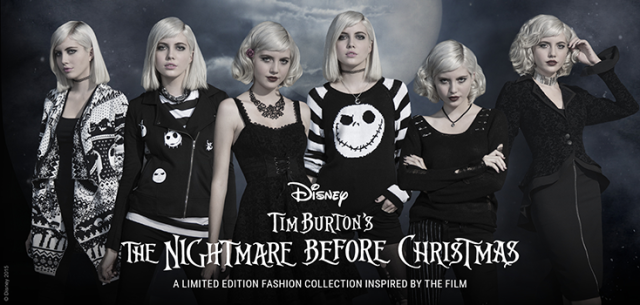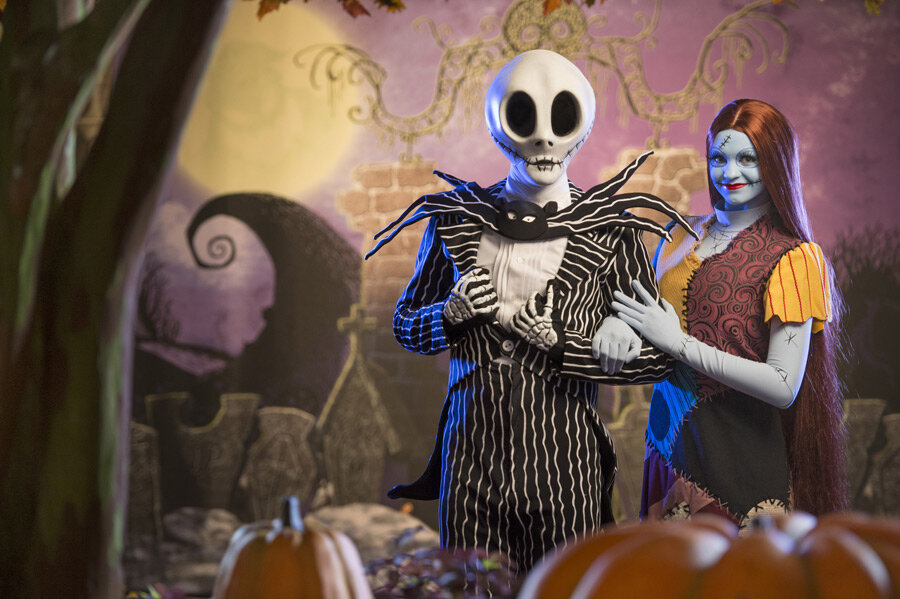“Simply Meant to be?” Locating Tim Burton’s Nightmare Before Christmas at the Disney Theme Parks
When Tim Burton’s Nightmare Before Christmas (Henry Selick, 1993) first hit cinemas in 1993, its status as a Disney film was not immediately clear. The film was released via Disney’s Touchstone label and the Company was initially concerned about the “dark tone and potential negative reception of the film’ (Burger 2017, 110). Such dissonance has lessened in the years since the film’s release through Disney and Burton’s more recent partnerships on the stop-motion animated Frankenweenie (Tim Burton, 2012) and live-action remakes of Alice in Wonderland (Tim Burton, 2010) (and its sequel Alice Through the Looking Glass [James Bobin, 2016]) and Dumbo (Tim Burton, 2019). Even before these later creative collaborations, however, Nightmare Before Christmas evolved “From cult classic to merchandising juggernaut, the film has gradually achieved mainstream acceptance within the Disney canon, and as one Forbes article put it, a growing cultural embrace of “otherness” has turned their “illegitimate child” into “their proverbial favorite son”” (Cuthill 2017, 89).
Although the film has been much analyzed in terms of its animation (McMahan 2005; Cuthill 2017), representations of gender (Mitchell 2017), and its use of fairy tales (Burger 2017), Nightmare Before Christmas not only ‘lives’ within the text of the movie. Its numerous paratexts include the original book on which it is based, comics (including the Manga series Zero’s Journey), and board games, and the ever-expanding rage of merchandise that has seen it “become a touchstone for adolescent counter-culture and a sine qua non staple of “Goth” closets”. (Cuthill 2017, 89) (Fig. 1). Alongside these physical objects, however, Nightmare Before Christmas also lives on in Disney’s theme parks where it materializes and dematerializes, much like Jack Skellington’s ghost dog Zero, between October and January each year. As this blog post will demonstrate, the physical sites of Disney’s theme parks demonstrate the tensions around the corporate sanctioning (and incorporation of the film), and its move away from its initially industrially ambiguous status. It is also here where the film moves outside of its animated origins, enabling fans and theme park guests to blur the lines between the fantastic and the ‘real’ and to engage in imaginative play to make Nightmare Before Christmas come to life.
Based on a film that deliberately incorporates the aesthetics of Halloween and Christmas - inspired by Burton’s observations of Halloween and Christmas decorations being displayed in shops at the same time (Cuthill 2017, 89) - it is unsurprising that the Disney Parks would deploy characters from Nightmare Before Christmas at celebrations for both seasons. Halloween events such as Mickey’s Not So Scary Halloween Party in Orlando’s Walt Disney World, or the Oogie Boogie Bash at Disneyland Paris allow guests to meet Jack Skellington, Sally, or Oogie Boogie and to see the characters participate in parades and cavalcades. Such opportunities are hugely popular with guests since these characters are available only for a limited time; as such, lines to meet them can often extend to several hours. The meet-and-greets also offer a unique chance to meet in-person characters that have existed only in animated form as stop-motion figures (Fig. 2).
Haunted Mansion Holiday.
This form of ‘ani-embodiment’ where “the characters are costumed actors [and] it is not they who are objects of adoration but the fictional figures they stand in for” (Williams 2020, 134) allows guests at the theme parks to meet the ‘celebrity’ figures of Jack, Sally and Oogie Boogie. This can be especially meaningful when meeting “those whose origins are in animation and who do not (and cannot) exist outside of the animated world but who have become ‘alive’ via their personification through costumes, mannerisms, behaviours, and the literal body of the theme park cast member.” (Williams 2020, 140). Here the visitor’s imagination is key as they engage in playful interaction with characters, showing a ‘willingness to participate in [the Park’s] illusions’ (Carson 2004, 231) and entering into moments that blur the distinction between fantasy and reality and animation and the physical embodied character in front of them. As J. P. Telotte notes, Disney in particular “offers not just an illusion or pleasant fantasy, but ultimately a different awareness, actually a kind of play or playfulness” (2011, 181) which we can see in the case of character meet and greets. In the moment of meeting Jack Skellington, the theme park actor is a subsumption of many of his referents – the stop-motion model, the voices of Danny Elfman and Chris Sarandon, the physical body of the cast member playing the role.
However, it is during the Christmas period where Nightmare really takes centre stage within the Parks (Inside the Magic 2014). The film is primarily drawn on in Disneyland in California and in Tokyo Disneyland where one of the Parks’ iconic attractions, the Haunted Mansion, receives a festive ‘overlay’ and becomes known as Haunted Mansion Holiday in the US (Fig. 3) and Haunted Mansion Holiday Nightmare in Japan (Paris’ Phantom Manor and Florida’s Haunted Mansion remain untouched, although guests can meet Jack Skellington in his Sandy Claws outfit at events at both parks) (see right).
The Haunted Mansion Holiday works as a remix of the Haunted Mansion attraction itself, whilst also extending the storyworld of the Nightmare universe. Narratively set after the events of the film, Haunted Mansion Holiday’s central conceit is that Jack has discovered the house and wants to celebrate the festive season with the 999 ‘happy haunts’ who live there. The ride thus allows guests to physically enter into the film’s imaginary worlds of Halloweentown and Christmastown and the Haunted Mansion simultaneously, speaking to the Gothic ricketiness of the permanent attraction. The Haunted Mansion itself has a dedicated fan following (Baham 2014), and many “have long sought a greater depth of story for the ride, requests that Disney has, in part, responded to. The Mansion demonstrates how fans can contribute to the development of transmedia narratives and storyworlds as much as official producers and institutions” (Williams 2020: 117). It is precisely because the Mansion lacks a coherent and stable story that fans can ‘fill in the gaps’ and also why, in addition to the overlaps in aesthetics and mood, it works as the foundation for the Nightmare overlay. The origins of the Mansion are sufficiently vague to allow another story to be told alongside (or over) its own experience, allowing fans of both the ride itself and Nightmare Before Christmas to briefly inhabit these fictional worlds and to imagine future stories within those fantastic universes (Fig. 4).
We might question why a lucrative and popular intellectual property such as Nightmare does not have a permanent presence in the Disney Parks. However, its deployment as an intermittent overlay or attraction speaks to its precise temporalities, indicating the arrival of the Halloween or Christmas season and inaugurating the moment for fans of the film. In allowing guests to inhabit its fantastic worlds only briefly, Haunted Mansion Holiday remains demarcated as special and unique. Perhaps industrially, however, it also speaks to the film’s ongoing ambiguous place within the Disney canon given its subject matter and Gothic aesthetics. In using Nightmare in this way, Disney’s “illegitimate child” (Cuthill 2017, 89) can be embraced only on a temporary basis without threatening Disney’s corporate brand and identity before being consigned back to its appropriate place for the rest of the year. Whatever the reasons, much like Christmas itself, the chance to meet Jack Skellington and to physically enter into fantasy worlds otherwise seen only on-screen in animation continues to come just once a year.
**Article published: December 11, 2020**
References
Baham, Jeff. 2014. The Unauthorized Story of Walt Disney’s Haunted Mansion. United States of America: Theme Park Press.
Burger, Alissa. 2017. “Deconstructing (and reconstructing) the fairy tale in Tim Burton’s The Nightmare Before Christmas and Corpse Bride.” In A Critical Companion to Tim Burton, edited by Adam Barkman and Antonio Sanna, 107-116. Maryland: Lexington Books.
Carson, Charles. 2004. “Whole New Worlds: Music and the Disney Theme Park Experience.” Ethnomusicology Forum 13, no. 2: 228–235.
Cuthill, Christopher M. 2017. “Reading Burton’s Nightmare Before Christmas with Paul Tillich’, in A Critical Companion to Tim Burton, 89-106.
McMahan, Alison. 2005. The Films of Tim Burton: Animating Live Action in Contemporary Hollywood, London: Continuum.
Mitchell, Donna. 2017. “Doll doubles: Female identity in Tim Burton’s Stop-motion Films.” In A Critical Companion to Tim Burton, 230-240.
Inside the Magic (2014) ‘FULL Haunted Mansion Holiday 2014 Ride Though at Disneyland’, YouTube (September 12, 2014), available at: https://www.youtube.com/watch?v=bvqz4t4O2Wg
Telotte, J. P. 2011. “Theme Parks and Films--Play and Players.” In Disneyland and Culture: Essays on the Parks and Their Influence, edited by Kathy Merlock Jackson and Mark I. West, 171–182. Jefferson, North Carolina: McFarland.
Williams, Rebecca. 2020. Theme Park Fandom: Spatial Transmedia, Materiality and Participatory Cultures, Amsterdam: Amsterdam University Press.
Biography
Rebecca Williams is Senior Lecturer in Communication, Culture and Media Studies at the University of South Wales. Her publications include Theme Park Fandom (2020, University of Amsterdam Press), Post-object Fandom: Television, Identity and Self-Narrative (2015, Bloomsbury), Torchwood Declassified (2013, I.B. Tauris), Everybody Hurts: Transitions, Endings, and Resurrections in Fandom (2018) and Fan Studies: Method, Research, Ethics (forthcoming) with University of Iowa Press.




